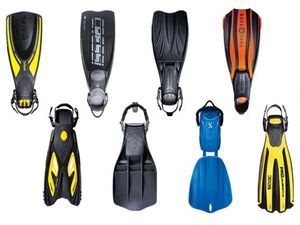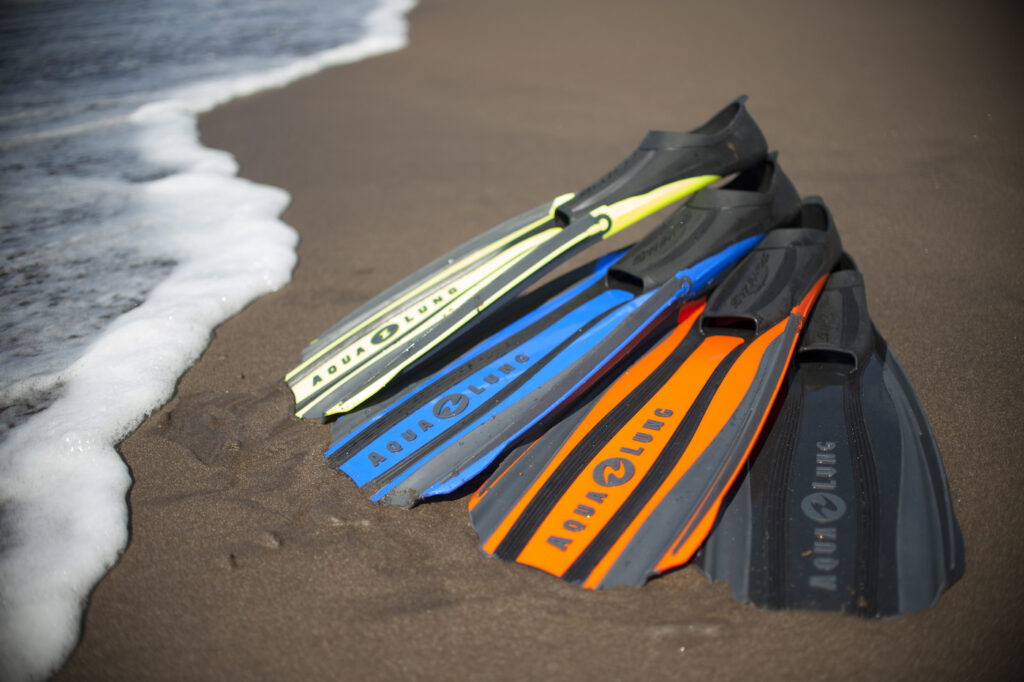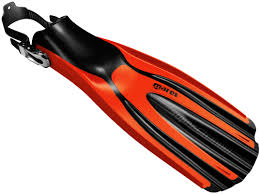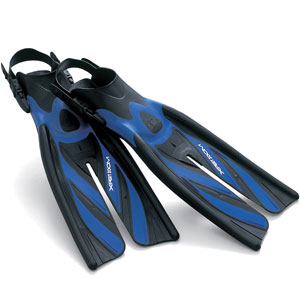
There is a vast array of fins on the market and you will need to consider your level of experience, kicking style and ability, leg power and type of diving you will be doing in order to determine which type of fin will best suit you. Diving fins should neither be too short (snorkelling fins), or too long (like free diving fins). As a general rule, the stronger the leg, the longer and stiffer the fin should be. However, fins with rigid sides and a flexible middle made up of different materials will generally provide more thrust power with less effort. Many top end fins will incorporate a number of materials in the blade and foot pocket including carbon fibre, graphite and polymers to maximise the amount of energy transfer from the leg to the fin. Believe it or not, there is a great deal of science that has gone into the manufacture of fins!
Closed Heel or Open Heel?
Full foot fins are usually cheaper than open heal fins, easy to don and less bulky, however, if they are not a perfect fit for you will cause lots of friction issues and blisters. Never compromise, always go for fit when selecting full foot fins. Do not be talked into buying wet suit socks to ensure a proper fit for full fit fins or be tempted to purchase full foot fins where your toes feel cramped because they are on sale! If your fins stay on at your heel, they will not fall off in the water. Quite simply put, if full foot fins do not fit perfectly do not purchase, you are wasting your money and will live to regret your decision.
The downside of a full foot fin is that is the water is cold, they do not offer any thermal protection for your feet. Another negative is, if you are shore diving, you will need to consider where you will be walking as, without boots, your feet will be vulnerable over rock pools and similarly on hot dive decks.

As a result of the restrictions on full foot fins, most divers tend to go for an open heel fin type where a neoprene dive boot or dry suit boot is required to be worn underneath. Open heel fins are more adjustable, comfortable and versatile than full foot fins and provide cushioning and chafing protection, but tend to be bulkier, more expensive and can have complex strap adjustment mechanisms. An open heel fin worn with a dive boot will offer thermal protection in colder water and given that water is a much better conductor of heat than air is. Versatility is key with an open heel fin, the same fin being able to be worn with a pre-fitted dry suit boot or even a pair of trainers, eliminating the need for multiple fins being required in different conditions. Open heel fins also have the added advantage of providing additional stability and maximum propulsion. Whilst fit will vary between style and manufacturer, most manufacturers will provide a shoe size range as a guide for each fin size to make fitting a little easier.

Split Fin vs Paddle Blade?
Ask any experienced diver or dive professional this question and it will undoubtedly provoke a lively discussion! Whilst paddle blade fins have been around for many years, split fin technology is a relatively recent addition to diving.
The whole idea of a split fin is that the blade causes a vortex in the water as you swim along. Also, on the divers upward fin stroke, where minimal propulsion is achieved in any fin, the split blade opens up and allows water to easily pass through. These features essentially provide excellent propulsion for less effort and ensure that a split fin is more efficient than a paddle fin. In essence, split fins are easy to use and as a result, many divers find that they can conserve up to 40% more air with a split fin over a more traditional paddle blade. People who suffer from cramping, are injured or have weak knees, ankles or back problems will benefit from using split fins because they are so easy to use.

Well, whilst split fins may be more efficient than paddle blades, they are not as powerful. What this means is that whilst split fins may be easy to use when the conditions are good, when the conditions turn, you simply will not have the power that a paddle blade fin can offer. In any sort of current, give me my paddle blade fins any day over splits! Because of the extra grunt that a paddle blade will offer, they tend to be the preferred option for most dive professionals when power is key for chasing students, conducting rescues and so on.
In summary, you really need to assess the type of diving that you intend on doing most of. If this involves cruising around on easy sites with little current, or you are prone to cramping or nursing an old injury, then splits are probably the answer for you. If however, you want to go on and do more technically demanding diving in conditions that are less than perfect, go for a paddle.
Article written by Author J9 on http://divebuzz.com
